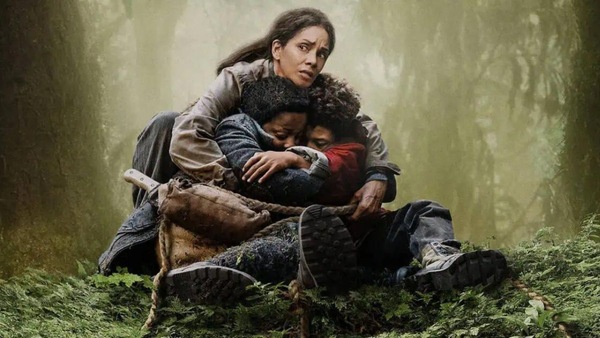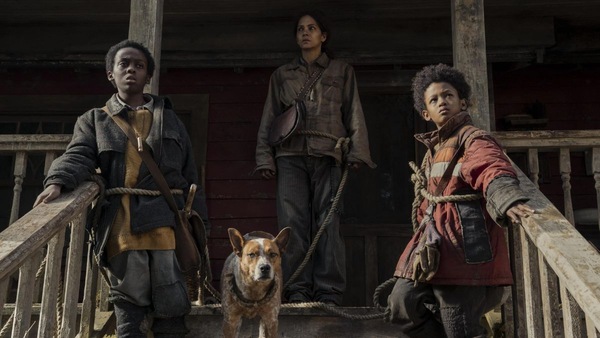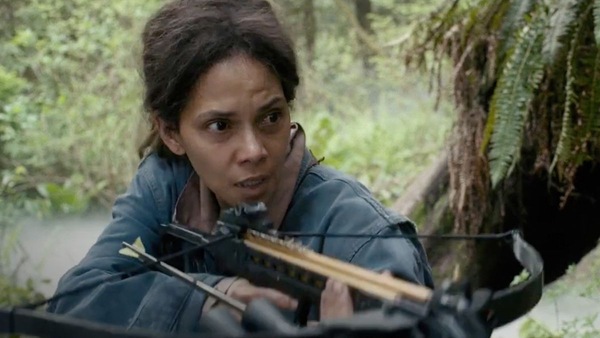Never Let Go Is A Survival Thriller Haunted By The Ghost Of Shyamalan Movies
Never Let Go remains indecisive about its own identity. It’s so preoccupied with derailing the viewer and their preconceived notions that it ultimately loses sight of its voice.

Promo poster for Never Let Go
Last Updated: 05.44 PM, Sep 20, 2024
ANOTHER WEEK, another unwitting reminder that nobody can do a Shyamalan movie like Shyamalan himself. Of all the modern influences and post-apocalyptic horror titles that Alexandre Aja’s Never Let Go derives its mystery from, The Village (2004) is right up front. The narrative gimmick is that the viewer – like the story’s young protagonists – is supposed to question whether they’re confronting a horror movie at all. The cultural gimmick is that the setting is just about unoriginal enough to make you doubt its legitimacy. There’s a cabin in the woods. A woman (Halle Berry) lives there with her twin sons, Nolan and Samuel. All is not well.
The rules are clunkily communicated to us through a voice-over: They’re the last surviving humans on a planet that was possessed by Evil years ago. She had to kill her husband and parents. A touch from those malevolent forces is all it takes. The cabin home is their holy sanctuary, and they are to be attached to its ropes at all times if they step out. Food is scarce; they’re down to eating bugs, frogs and fried barks of trees. The family dog keeps them company. Also, the main catch is that only the woman can see the spirits. The kids cannot. They have to blindly trust their mamma.
Nolan soon starts to punch holes in the logic of his mom’s storytelling. He wonders if she’s telling the truth. He’s not as brainwashed – or perhaps as unblinkingly loyal – as his brother Samuel. The film-making poses a few obvious questions: Is the Evil she speaks about real? Or are they figments of the very potent imagination of a mentally ill mom who wants to ‘protect’ her twins from the inherently bad world beyond? The Village closed with a revelation that the haunting of the quaint 19th-century community in the woods by a red-hating demon was an elaborate conspiracy – a fable – concocted by the elders to protect their future generations from the evils of modern civilisation. It kept the kids within the boundaries of their settlement. The elders wanted to stay frozen in time and space at any cost, and chose a protected area of a wildlife reserve that stayed hidden from the outer world.

When Never Let Go starts to mine this ambiguous space between what it looks like and what we think it is – and also assumes we’ve watched enough horror to stay in doubt – it’s a fairly effective film. Because at this point, the reality of it all lies in the eyes of the beholder. You believe Nolan and his pragmatism, but Berry’s deluded motherhood is so compelling that you wonder whether this is a film about possessive people or possessed humans. At points, she looks like she’s doing precisely what the elders of The Village did, except she’s struggling to maintain this difficult illusion on her own. A past is hinted at, but her answers are so curated that it sounds like she’s almost convincing herself.
The fact that the family is Black further feeds the possibility of a troubled American parent isolating her kids and their innocence from a racist and brutality-laden country. That she’s harming them in the process is not the smoothest metaphor for helicopter parenting and psychological imbalance. As a viewer, it’s hard to not root for Nolan (an ode to the famous director and his myth-infused dysfunctional-family narratives?), because he is a realist stuck in a cage of quasi-religious fear. Percy Daggs IV, as Nolan, walks the thin line between a child speaking like an adult and a child forced to grow up faster than he would’ve liked. It’s a nice companion piece to Berry’s sweaty ambivalence. Anthony B. Jenkins, as Samuel, has less of the crowd-pleasing character, but he uses his face wonderfully to convey the Kane-and-Abel parables.

But the problem with Never Let Go is that it remains indecisive about its own identity. It’s so preoccupied with derailing the viewer and their preconceived notions that it ultimately loses sight of its voice. The final act is more shock and awe and trickery without committing to a side. If anything, it becomes greedy, trying to channel the best of both worlds – supernatural and natural – to keep us invested and guessing. The guessing, however, becomes a chore by the end. I started to ask myself: Is it truly interested in making a point? Does the film itself know what it’s about?
The ending is so convoluted that it again proves how Shyamalan’s trademark twist was so much more than a gimmick; it rarely upended the spirit of the film, and a lot of the surprise felt well-earned. (That’s not to say Shyamalan is past tense; it’s just that early Shyamalan makes for a better case study in this context). Aja’s filmmaking tries to emulate the narrative and atmospheric subterfuge, but one can sense that he’s weighed down by the tropes of his favourite genre. He refuses to go all out. Or, in other words, he can never let go of his love for purist horror. The more chilling revelation is this: The mother is a stand-in for the conflicted director, and the twins are the story he so dearly strives to manipulate.
